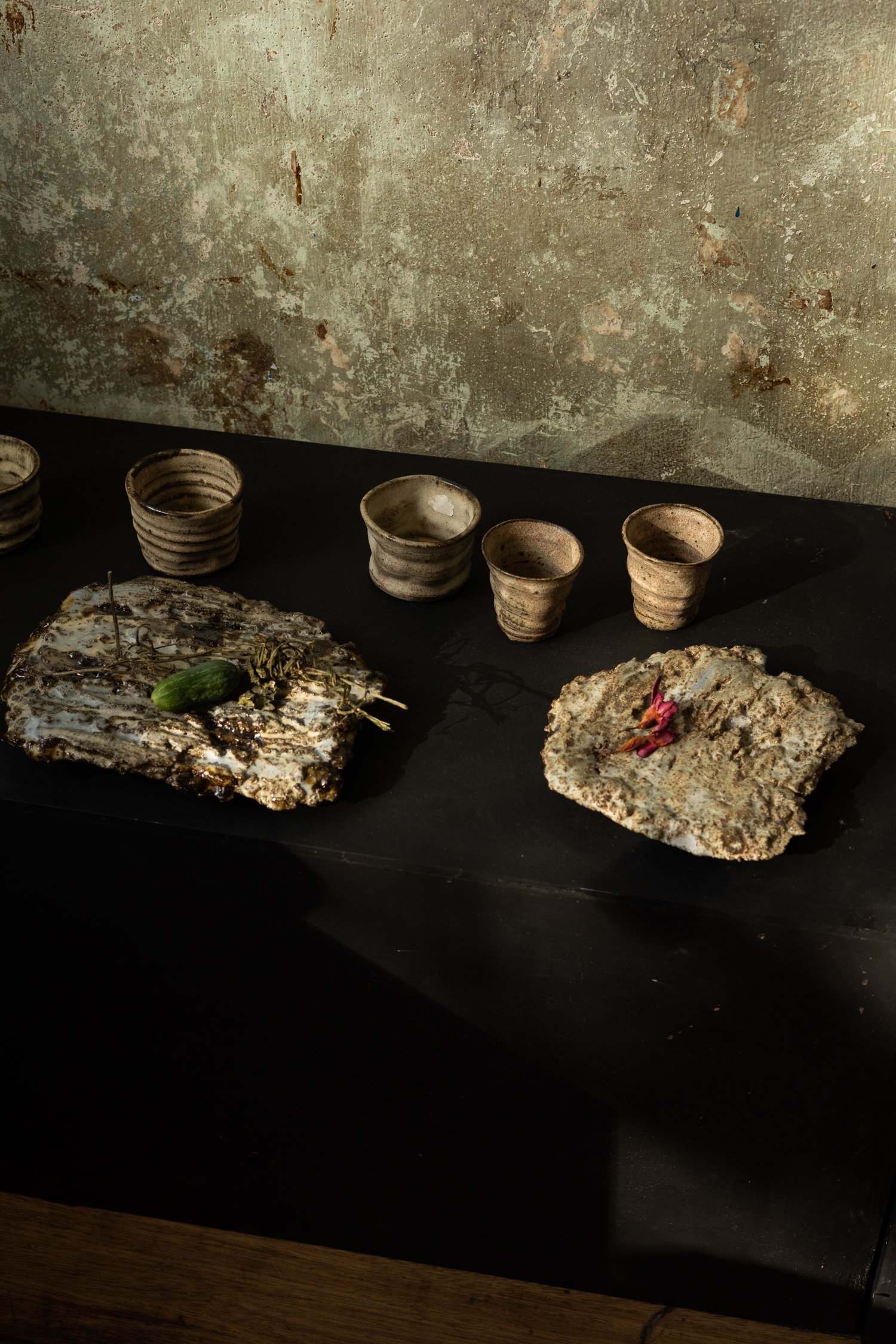Panchalie Sathirasas: In the Quiet World of a Bangkok Ceramic Artist
It was during our first visit to GalileOasis, two years ago, that we encountered the enigmatic world of Panchalie Sathirasas. Amidst the serene corners of this boutique hotel, her exhibition unfolded like a delicate whisper—showcasing bowls, plates, and drinkware, each piece a testament to the quiet strength of her artistry. The colours, the forms, the very essence of each creation spoke of a profound connection to something both ancient and deeply personal.
Panchalie’s Journey Through Art and Life
There she stood, the artist herself, offering warm tea in vessels of her own making. It was as though each sip brought us closer to the heart of her work, allowing us to savour not just the tea, but the very spirit in which it was crafted. Panchalie's approach to her art is not one of mass production or commercial gain. Instead, she chooses a path of quiet reflection and intentionality, unveiling her work only when the time feels right—sometimes years apart. This creates a subtle, yet powerful, mystique around her creations and the woman behind them.
Though rooted in the vibrant chaos of Bangkok, Panchalie has carved out a world that feels worlds apart. In her quiet enclave, she has cultivated a sanctuary, where the noise of the city is but a distant hum. Here, in her garden, fresh galangal and morning glory thrive, much like her art—nurtured with care, flourishing in its own time.
In Panchalie, we find an artist of rare authenticity, one who embodies the essence of slow living in both her art and her life. She is not just a creator of beautiful objects, but a guardian of a way of being that is increasingly rare in our fast-paced world.
How It All Began
Panchalie's love for pottery took root in her childhood, inspired by the sight of an old woman shaping clay on a wheel. This early experience marked the beginning of a deep connection to the craft. But it was a Japanese novel that truly fuelled her passion. The story, with its vivid descriptions of Japanese tea bowls, captured her imagination, blending the lives of its characters with the significance of the pottery they used. Through these pages, Panchalie found herself drawn to the simplicity and beauty of the tea bowl.
In her twenties, Panchalie became deeply engrossed in this newfound interest. She would spend countless hours at night, reading about Japanese pottery, absorbed in its history and techniques until dawn. The way these works were described resonated with her, each piece presented with care and reverence. One day, she wandered into a bookshop and stumbled upon a small volume titled Invitation for Tea. As she opened it, she was met with the image of a bowl, precisely like the one she had read about in the novel that had touched her so deeply years before.
“I almost collapsed to the floor,” Panchalie recalls, “and found myself in that bookshop with tears running down my face. It was as though I had met the love of my life, waiting for me all this time.” In that moment, she made a vow to herself—to master the art of creating these unique bowls, even if it took her twenty years to do so. For Panchalie, mastering this craft was not merely an artistic goal; it was a personal journey of self-discovery. She had finally found her purpose.
But, as it turned out, twenty years were not necessary. Through sheer dedication, it took Panchalie only five years to achieve mastery. She honed her skills in Canada, where her journey with pottery truly began. Despite her teacher’s warnings not to return to Thailand—citing the challenges of making a living from her art in a country that favoured colourful, vibrant pottery over the neutral tones Panchalie loved—she remained resolute. She knew the road ahead would be difficult, but she was undeterred. Panchalie’s only wish was to find one or two souls who would fall in love with the art she created. For her, that would be more than enough.
The First Exhibition
For two years, Panchalie dedicated herself entirely to perfecting her pottery skills. From morning until night, she practised relentlessly, working at home to truly master her craft. Approaching her thirties, she was also juggling a career as a journalist to make ends meet. Eventually, she decided to leave her job behind and devote herself fully to pottery.
Her first exhibition, as she recalls, was an unexpected triumph. She nearly sold out on the first day. At the time, she displayed her work in hotel galleries—not a common practice then, but she managed to find a few places willing to showcase her art. With no formal résumé to present, Panchalie instead wrote a poem, which she sent to the PR manager. This unconventional approach paid off, capturing their attention. The poem she composed wasn’t about her professional achievements but rather about her childhood in the countryside. This deeply personal touch resonated, and the poem was eventually published in almost every newspaper and major magazine. It marked a period of great success, where people were drawn to her for her originality.
Though she now holds exhibitions infrequently, perhaps every two to three years, Panchalie has cultivated a loyal following over the years. Even during her long absences from the public eye, when she announces an exhibition, the response is always overwhelmingly positive. Her approach to art, and how she chooses to present it, has always stood apart. Panchalie does not conform to traditional expectations; uniqueness is at the heart of her work and her way of life.
The Art of Silence
In a quieter, residential area of Bangkok lies Panchalie’s retreat—a beautiful property where three small houses are set together, serving as both her studio and residence. It’s a calm haven, where the heart of her world is found in the space where she creates her exquisite pottery. This space, where her vision comes to life, is effortlessly beautiful, reflecting her refined taste.
After spending a few days with her, we came to understand something significant—an aspect of her life that had shaped her current way of living: noise. A few years ago, the relentless sounds of Bangkok became overwhelming for her. Her sensitivity to the city's constant din made it impossible to continue living in the bustling heart of the city. This prompted her move to a more peaceful corner of Bangkok, a place so serene it’s hard to believe it’s still within the city limits. Here, she has found a way to embrace her city, but in a manner that allows for peace and quiet.
Her neighbourhood invites gentle walks along streets where you can find morning glory vegetables, lemongrass, galangal, and kaffir lime growing wild, for anyone to take. This is the essence of Thailand—a land that offers raw, natural beauty at every turn, an open garden that thrives everywhere you go. It is perhaps this simplicity, this untamed nature, that deepens Panchalie’s love for her homeland. Thailand is not just one of the world’s most beautiful countries; it’s a place that offers a life rich in raw, slow living, a rhythm that resonates deeply with her soul.
Now, every two to three years, Panchalie unveils her work, living in her Bangkok home, creating art daily, and embracing life on her own terms. To us, she embodies authenticity in its truest form. She cooks with elegance, using flowers as decoration and presenting her dishes in her own handcrafted creations. She lives and breathes art. Thailand is home to many hidden gems, but she is, without a doubt, one of the most precious treasures we have discovered in this beautiful country.
Read more about GalileOasis and Panchalie’s exhibition






































